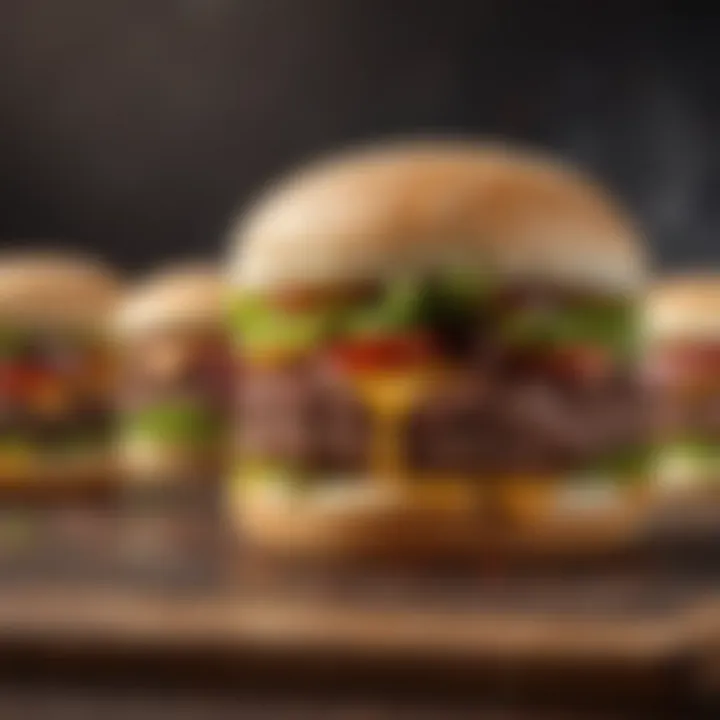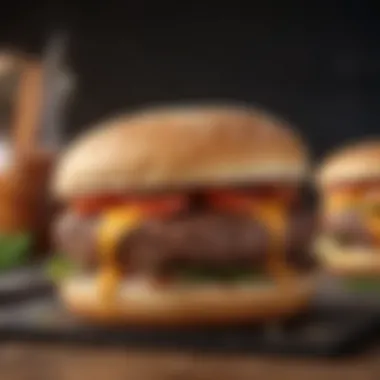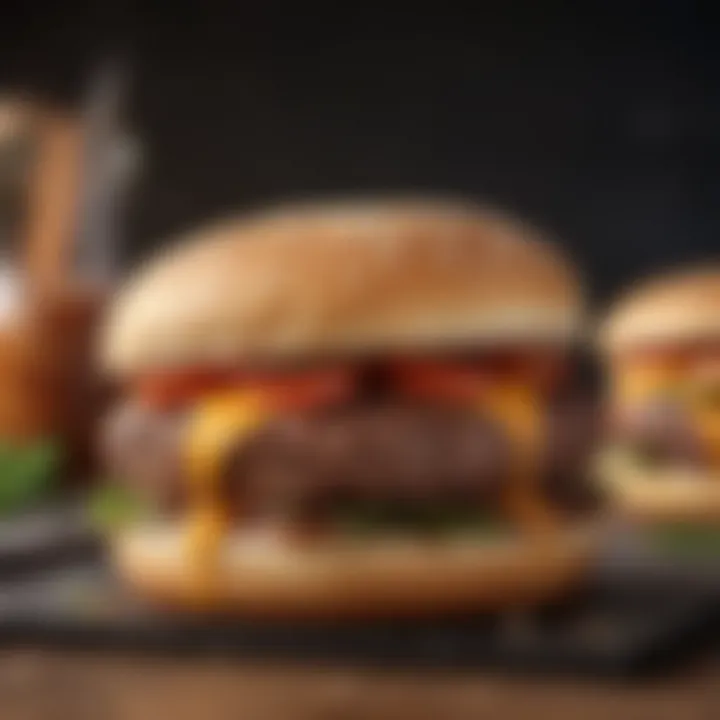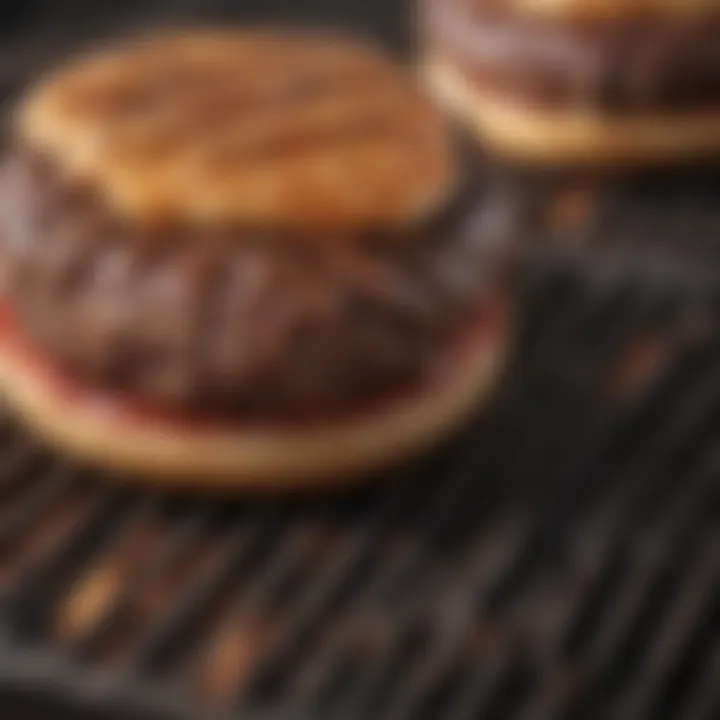Crafting Perfect Burgers from Ground Beef


Intro
Ground beef is a versatile ingredient that forms the backbone of one of the most beloved comfort foods: the burger. The art of creating the perfect burger goes beyond just cooking meat. It involves a careful selection of ingredients, mastery of techniques, and an understanding of how to balance flavors and textures. Whether you are preparing a meal for yourself or entertaining guests, an expertly crafted burger leaves a lasting impression.
To embark on this culinary journey, we will explore several core elements that contribute to transforming ordinary ground beef into a delicious burger. The insights provided will help both novice and seasoned cooks alike to elevate their burger game. From choosing the right beef to mastering cooking techniques, let’s dive in and uncover what makes a burger truly remarkable.
Understanding Ground Beef
Understanding ground beef is a crucial step in mastering the art of burger making. The quality, flavor, and texture of your burger depend significantly on the type of ground beef you choose. This section emphasizes the importance of being informed about the composition and the different cuts that can yield ground beef, ensuring that your end product delivers the best taste and satisfaction.
Moreover, knowing the fat content in ground beef is necessary. The right balance can keep your burgers juicy while also enhancing the flavor. Grip on these elements aids in making informed decisions that can elevate your culinary creations.
Composition of Ground Beef
Ground beef is made from various cuts of beef, ground together to create a cohesive product. Quality ground beef should have a balanced mix of lean meat and fat since these attributes govern the flavor, texture, and moisture. The composition of ground beef can also affect its cooking properties and how it reacts to seasoning and heat.
Different Cuts of Beef
Chuck
Chuck is a prevalent choice for ground beef due to its rich flavor and ideal fat content. Taken from the shoulder area, it tends to have a good balance of meat and fat which results in a juicy and flavor-packed burger. The higher fat percentage in chuck helps keep the burger tender even when cooked. However, it is essential to monitor cooking times because the fat can cause flare-ups when grilling.
Brisket
Brisket is another flavorful cut often ground for burgers. Coming from the chest area, brisket has a distinct taste and a higher fat content than some other cuts. Burgers made with brisket can be particularly juicy and are known for their depth of flavor. One downside is that brisket can be pricier than other cuts, which may not suit all budgets.
Sirloin
Sirloin provides a leaner option for ground beef. Cut from the back of the cow, it has a moderate fat content and offers a good flavor without being overly greasy. Burgers made from sirloin are often lean and can be a healthier alternative. However, those who prefer a richer taste might find sirloin less satisfactory compared to cuts like chuck or brisket.
Round
Ground round is a leaner choice that comes from the hindquarters of the cow. This cut usually yields less fat and produces burgers that are lean but may require careful seasoning to keep them flavorful. One must ensure that some moisture-enhancing ingredients are included, as a lack of fat can lead to a dry burger. The ground round can be desirable for those watching their fat intake.
Beef Fat Content
Importance of Fat
Fat plays a significant role in the flavor and juiciness of ground beef. It acts as a flavor carrier and contributes to the texture of the burger. Having some fat ensures the burger remains moist during cooking, enhancing the overall experience.
Choosing the Right Ratio
Choosing the right fat-to-lean meat ratio is vital for an enjoyable burger. Most experts recommend a blend of 80/20, meaning 80% lean meat to 20% fat. This ratio helps in achieving a juicy burger that does not dry out while cooking, while still providing a satisfying bite. Understanding these principles allows you to select the right ground beef for your specific burger preferences.
Selecting Quality Ground Beef
Selecting quality ground beef is fundamental in crafting delicious burgers. The right choice can dramatically affect taste, texture, and healthiness. Understanding the various qualities of ground beef ensures that your burgers are not only flavorful but also made with ingredients that align with your dietary preferences. Quality beef often translates to a better overall burger experience.
Freshness Indicators
Freshness plays a critical role when choosing ground beef. Indicators of freshness include:
- Color: Fresh ground beef typically displays a bright red color. Darker shades may suggest aging or improper storage.
- Smell: A fresh cut should have a clean scent. Any off-odors should raise concerns about its viability.
- Texture: Ground beef should feel firm and slightly moist. Excessive dryness or stickiness can indicate poor quality.
It is advisable to check the expiration dates on packaging to determine freshness. When purchasing from a butcher, do not hesitate to ask questions about the meat's handling and sourcing.
Grass-Fed vs. Grain-Fed
The debate between grass-fed and grain-fed beef often comes down to personal preference and health considerations. Each type has its unique characteristics:
- Grass-Fed Beef: Typically contains higher levels of omega-3 fatty acids and vitamins such as E and A. It usually has a leaner profile with a slightly gamey flavor. Cooks may need to adjust cooking times as it can dry out faster.
- Grain-Fed Beef: This option generally yields more fat marbling, leading to a juicier burger. The flavor is often described as richer and more consistent. Grain-fed beef is commonly found in mainstream grocery stores.
Evaluating the benefits of each type can greatly inform your decision based on dietary needs or flavor profiles.
Organic and Hormone-Free Options
Organic and hormone-free ground beef options are rising in popularity among health-conscious consumers. These choices come with several benefits:


- Organic Beef: Sourced from cattle raised without synthetic pesticides or antibiotics. This method can promote better animal welfare and reduces exposure to chemical residues in the meat.
- Hormone-Free Beef: While most beef in the market is free from added hormones, certification is crucial for those concerned about hormone ingestion. Hormone-free beef ensures that you consume meat from animals raised without growth-enhancing substances.
By choosing organic or hormone-free beef, you are also supporting sustainable farming practices, which can have a positive environmental impact.
Essential Ingredients for Burger Patties
Creating a delicious burger begins with understanding the essential ingredients that contribute to its flavor and texture. The quality and selection of these elements can significantly impact the overall success of the burger. This section outlines the foundational components needed to craft an appealing burger patty, as well as optional enhancements that can elevate the basic recipe. By focusing on these ingredients, home cooks can ensure a satisfying outcome.
Basic Ingredients List
Ground Beef
Ground beef stands as the cornerstone of burger patties. Its primary role is to provide the meat component, which defines the burger. What makes ground beef a favored choice is its natural flavor, which can be enhanced further with seasonings. The texture of ground beef allows it to form compact patties while retaining moisture during cooking, preventing dryness. However, it's critical to choose the right fat content, which affects not only flavor but also juiciness. Generally, an 80/20 beef-to-fat ratio is popular because it strikes a good balance between tenderness and flavor. Too lean, and the patty may turn out dry; too fatty, and it can become greasy.
Salt
Salt is more than just a flavor enhancer; it plays a vital role in the cooking process. When added to burger patties, salt helps draw out moisture, which can then be reabsorbed, enhancing the meat's juiciness. It also aids in forming a crust during cooking, contributing to texture. The key aspect of salt is its ability to amplify the natural taste of the beef without overpowering it. A common practice is to season the patties just before cooking, ensuring that the salt remains effective.
Pepper
Pepper adds a layer of spice that can elevate the burger's flavor profile. It's a simple but effective ingredient. A generous sprinkle of freshly ground black pepper can complement the natural taste of beef incredibly well. While some recipes might call for different types of pepper, black pepper is widely regarded due to its sharp yet complementary heat. However, too much can overpower the meat, so balance is crucial.
Optional Enhancements
Garlic Powder
Garlic powder provides a savory depth to ground beef that can elevate the taste. Unlike fresh garlic, garlic powder integrates evenly into the meat mixture, ensuring a consistent flavor throughout the patty. It is particularly popular in burger recipes because it adds umami without the acidity that can come from fresh garlic. Moreover, garlic powder is more shelf-stable and easy to use, making it a practical choice. A moderate amount is usually sufficient to avoid overwhelming the other flavors.
Onion Powder
Onion powder serves a similar purpose to garlic powder, offering a sweet and savory note. This ingredient blends seamlessly into the meat, providing a subtle flavor that complements the beef. Onion powder is beneficial because it allows cooks to add flavor without the texture of fresh onions, which may not appeal to everyone. Less pungent than fresh onions, it can support other seasonings without clashing.
Soy Sauce
Soy sauce is a unique ingredient that introduces a salty, umami flavor. It can help enhance the juiciness of the patties due to its liquid form, which contributes moisture. However, caution is warranted, as its strong flavor can dominate if used excessively. A small splash can add depth without being obvious. This ingredient is ideal for those seeking a little Asian twist on traditional burgers.
Herbs and Spices
Herbs and spices provide an opportunity for creativity in burger preparation. Cook can customize their patties by adding a range of flavors. Common choices include parsley, paprika, or even cayenne for a bit of heat. Each herb or spice can alter the taste experience significantly. The unique feature of utilizing these ingredients is that they can cater to various palates and dietary preferences. However, one must be cautious not to overcrowd the flavor, as too many can mask the natural taste of the beef.
"The right combination of these essential and optional ingredients can truly transform a simple burger into a mouthwatering experience."
Techniques for Forming Burger Patties
The process of creating an ideal burger patty begins with proper techniques for forming it. Attention to detail in this stage can greatly enhance both texture and flavor. Skill in shaping your patties not only affects the cooking process but also ensures a satisfying eating experience. Different methods exist for forming patties, and each has its own merits and drawbacks. This article segment will navigate you through the various techniques available, informing you how to execute them effectively.
Hand-Shaping Patties
Hand-shaping patties is a traditional method that many cooks prefer. By simply using your hands, you can apply personal touch to the patties. This method allows for full control over the thickness and shape, catering to individual preference. A benefit of this approach is that it can yield a more rustic, homemade appearance.
When hand-shaping, it is important to handle the meat minimally. Over-manipulating it can lead to a denser, tougher final product. Instead, gently form the meat into a ball before pressing it down to the desired thickness. Consider using wet hands to prevent the meat from sticking, providing a smoother shaping process.
Using a Burger Press
A burger press is a tool designed specifically for shaping patties. This method can provide uniformity in size and thickness, ensuring even cooking. Additionally, a burger press helps in achieving a consistent patty shape, which is aesthetically appealing when plated.
Using a burger press is rather straightforward. First, weigh your ground beef to achieve consistency across all patties. Portion the meat into equal amounts, and place each piece into the press. With a little force, the press will form the patty evenly. While this method is efficient, take care not to compact the meat too firmly. This practice can lead to loss of moisture, making your burgers dry when cooked.
Pitfalls to Avoid
Avoiding some common mistakes can significantly improve the quality of your burger patties. Here are a couple of vital points to consider:
Avoiding Overworking the Meat
Overworking the meat is a fundamental mistake. Ground beef should maintain some air pockets, allowing it to remain tender during cooking. If you knead or mix the meat too much, you risk developing a denser texture. This characteristic not only compromises the qualitative aspect of the patty but also affects the overall flavor. Therefore, it is a beneficial choice to shape your patties quickly and minimally.
Creating an Indentation


Creating an indentation in the center of the patty is a small yet significant technique. It helps ensure even cooking, allowing the center to reach the desired doneness without overcooking the edges. This approach can alleviate the common problem of the patty puffing up during cooking. Establishing this unique feature is also a popular practice among chefs, as it contributes to the overall texture and bite of the finished burger. With significant advantages, this technique is a practical consideration when forming patties.
"Attention to the details in forming patties makes a noticeable difference in the final burger experience."
Understanding these elements of patty formation is crucial for any home cook looking to elevate their burger-making skills. By mastering shaping techniques and avoiding common pitfalls, you will be on your way to crafting satisfying and flavorful burgers.
Cooking Methods for Burgers
Cooking methods for burgers play a crucial role in how flavors develop and how the final product is perceived. Each technique brings unique characteristics that can impact the taste, texture, and moisture content within the patty. Understanding these cooking methods helps home cooks to make informed choices based on the type of burger they wish to create.
Grilling Burgers
Grilling burgers is often seen as an iconic method for cooking. This technique imparts a smoky flavor that is hard to replicate. A grill allows fat to drip away as the burgers cook, potentially resulting in a leaner final product. High temperatures create a desirable crust, enhancing both texture and taste. Moreover, grilling can allow for creative flavor combinations when wood chips or specific marinades are incorporated.
To grill burgers properly, preheat the grill until it is hot enough to sear the outside of the patty. Cooking over direct heat typically ranges from about 4 to 7 minutes per side for medium doneness. Keeping a close eye on them ensures that the burgers do not overcook.
"The perfect grilled burger pairs a juicy interior with a crisp exterior."
Pan-Frying
Pan-frying burgers is an approachable method for many home cooks. It allows for precise control of heat and cooking time. Using a cast iron skillet can contribute to a well-seared crust while retaining moisture inside the patty.
One of the key considerations in pan-frying is the choice of fat. Butter or oil can enhance the burgers. An important aspect is to use medium-high heat and ensure that the pan is hot before adding the patties.
For optimal results, flip the burgers only once and use a splatter guard to manage juices that escape during cooking. The searing effect also encourages flavor development through the Maillard reaction.
Broiling Techniques
Broiling is a less common method but can be effective for cooking burgers evenly and quickly. This method uses direct, high heat from above, which simulates grilling. Broiling can be beneficial when outdoor grilling isn’t an option or when cooking indoors is necessary.
The key is to set the oven rack close to the broiler and preheat the broiler before adding the patties. Broiling can take less than ten minutes, depending on the thickness of the burger. Adjusting the distance from the flame allows you to better control doneness while achieving a satisfying crust. This method can also be paired with toppings that melt easily, such as cheese, to create a delightful finish.
In summary, selecting the right cooking method for burgers depends on the desired result. Each technique has its benefits and considerations, from the traditional grilling approach with its smoky flavor to the convenient nature of pan-frying and the speed of broiling. Understanding these differences equips home cooks to achieve perfectly cooked burgers.
Temperature Control for Perfect Burgers
Temperature control is a crucial aspect that can determine the success of your burger-making endeavor. Proper temperature management impacts not only the doneness of the patties but also their flavor, texture, and juiciness. Understanding how temperature works in cooking ground beef is essential for any home cook serious about creating delicious burgers. This section will emphasize the significance of doneness levels and using tools like a meat thermometer to ensure that each burger reaches the desired state.
Understanding Doneness Levels
Each level of doneness represents a specific internal temperature, impacting both flavor and texture.
Rare
Rare burgers have an internal temperature between 120°F (49°C) and 125°F (52°C). The meat remains red and cool in the center. This doneness is favored by some for its tenderness and rich beef flavor.
- Key Characteristic: Rare burgers are juicy and soft.
- Popularity: Its popularity arises among fans of juicy, flavorful meat.
- Advantages: When cooked correctly, rare burgers can deliver unmatched flavor. However, there are disadvantages as well. The meat's lower internal temperature can lead to potential food safety concerns, particularly for those sensitive to undercooked meat.
Medium
Medium burgers are cooked to an internal temperature of 130°F (54°C) to 135°F (57°C). The center is warm and pink, balancing tenderness and flavor.
- Key Characteristic: Medium provides a firmer but still juicy bite.
- Popularity: Many choose medium for its flavor and safer choice compared to rare.
- Advantages: It offers the best of both worlds with a mix of juiciness and firmness. A possible disadvantage is that the meat can be less moist than rare, which some dining experiences may not prefer.
Well-Done
Well-done burgers are cooked to an internal temperature of 160°F (71°C) or more. The meat is fully cooked, with no pink remaining.
- Key Characteristic: The texture is firmer and drier than lesser doneness levels.
- Popularity: Well-done is preferred by individuals who prioritize food safety and minimal pinkness in meat.
- Advantages: This method eliminates concerns about undercooked meat. However, the texture may sacrifice some juiciness and flavor, leading to a less satisfying burger experience.
Using a Meat Thermometer
To achieve the perfect burger, a meat thermometer is one of the best tools a cook can have. It allows for accurate measurement of internal temperatures, ensuring that burgers reach the desired doneness without excessive cooking. The use of a meat thermometer helps verify that the meat is cooked properly, allowing you to serve burgers confidently and safely.
Burger Toppings and Recommendations
Understanding the various toppings and sauces that can accompany a burger is crucial for enhancing its flavor profile. The right toppings can elevate a simple patty into an extraordinary meal. Selection considerations include textures, flavors, and how these elements meld with the fundamental beef taste. Toppings not only add interest but can also provide health benefits and aesthetic appeal.


Classic Toppings
Lettuce
Lettuce serves as a common and beneficial topping due to its crisp texture. It adds a refreshing crunch to the burger, which balances the richness of the meat. Iceberg is popular for its water content and crunchiness, while romaine offers a more robust flavor. One advantage of using lettuce is its low calorie count, making it ideal for healthier eating. However, if not fresh, it can lose its texture and appeal.
Tomato
Tomato brings juiciness and acidity to the burger. The vibrant color and fresh aroma enhance the dish's visual appeal. Varieties such as beefsteak or heirloom tomatoes provide a flavorful punch. They contribute vitamins C and K. On the downside, if not in season, tomatoes can lack flavor and may detract from an otherwise well-crafted burger.
Onions
Onions are versatile toppings that can be used raw, caramelized, or grilled. They add sweetness and depth to the flavor. Red onions are raw and sharp, while yellow onions tend to be milder, especially when cooked. One of the benefits of onions is their strong aroma, which complements beef well. However, their strong flavor can overshadow other tastes, requiring careful balancing.
Pickles
Pickles provide a tangy crunch that complements the savory aspects of the beef. Their acidity cuts through the richness of the meat, providing a refreshing contrast. Dill and bread-and-butter varieties are popular choices, each offering distinct flavor profiles. A potential disadvantage is that not everyone enjoys the tartness of pickles, so offering a variety of toppings is advisable.
Specialized Sauces
Ketchup
Ketchup is a classic condiment often found on burgers. Its sweetness balances the savory qualities of the beef. The tomato base adds the familiar flavor many associate with traditional burgers. However, it may overshadow more delicate flavors of gourmet toppings, which might not appeal to all.
Mustard
Mustard adds a tangy kick and is available in many varieties, such as yellow and Dijon. Its sharpness complements the taste of the beef while adding complexity. This condiment is often lower in calories compared to others, making it a favored option among health-conscious diners. On the downside, its strong taste might not suit everyone’s palate.
BBQ Sauce
BBQ sauce brings a smoky sweetness to the burger, enhancing the overall flavor profile. Varieties can range from tangy to spicy, offering numerous options for enhancement. When paired with grilled burgers, it mimics the backyard barbecue experience. However, the heavy sweetness of some sauces can overwhelm the flavor of well-cooked beef.
Special Sauce Variations
Special sauce variations, often created from a blend of mayonnaise, ketchup, and spices, add a unique flair to a burger. These sauces can enhance the flavor and provide a creamy texture. Due to their custom nature, they can be tailored to suit a variety of tastes. The downside is that they may take extra preparation time, which might not be ideal for all home cooks.
Each topping and sauce contributes distinct flavors and textures. Balancing these choices is key to achieving a cohesive and enjoyable burger experience.
Bun Selection and Types
When crafting a burger, the selection of the bun can greatly influence the overall experience. A burger is not only about the patty; it is a complete dish involving every component. Hence, the bun must complement the flavors and textures of the beef and toppings. This section delves into the various types of buns available, outlining their characteristics and how to choose the right one to elevate your burger.
White vs. Whole Wheat
White buns are a traditional choice, often soft and slightly sweet. Their light flavor and airy structure make them a suitable canvas for various burgers. They absorb sauces well without overpowering the taste of the patty. However, they lack some nutritional value that whole wheat buns provide.
On the other hand, whole wheat buns are richer in fiber and nutrients. They have a denser texture and can add a slight nuttiness to the burger. This choice can appeal to those who prioritize health and nutrition in their meals. However, the stronger flavor profile of whole wheat may not mix as well with certain toppings or sauces. When choosing between these two options, consider the flavors of your burger combination. The balance between the bun and your ingredients is crucial for a satisfying bite.
Gluten-Free Options
In today’s culinary landscape, gluten-free buns have gained prominence. They cater to a growing number of individuals who must avoid gluten for health reasons. Common alternatives include rice flour, almond flour, or chickpea flour buns. Generally, these buns aim to replicate the texture of traditional options but can sometimes vary in density and flavor.
When selecting gluten-free buns, here's what to look for:
- Texture: Ensure it can hold the patty without disintegrating.
- Flavor: A bland bun can reduce the enjoyment of your burger. It should at least have a mild taste.
- Availability: Not all stores carry a robust selection of gluten-free types. Knowing local options can help.
These buns can be just as satisfying, given the right choice. Experimenting with different kinds can help in discovering the perfect match for your burger.
The right bun can transform an ordinary burger into a culinary experience, making it essential to choose wisely.
Plating and Presentation
The way a burger is presented on the plate can elevate the dining experience. Plating not only assists in appealing to visual senses but also conveys the care and attention invested in creating the meal. When making burgers, the presentation can be a subtle way to enhance flavor perception. Combine this with deliberate choices of sides and garnishes, and you transform a simple burger into a true culinary delight. In this section, we will explore the significance of aesthetics in burger presentation, and how selecting appropriate sides and complements can enhance the overall meal.
Aesthetics in Burger Presentation
The aesthetic aspect of burger presentation focuses primarily on color, texture, and arrangement. A well-presented burger can stimulate appetite. Bright vegetables like lettuce, tomatoes, and pickles add vibrant colors that make the dish more inviting. The arrangement of ingredients matters too. Placing the burger slightly off-center on the plate allows space to showcase toppings or a small side. Presentation is not just visual; it can also affect taste perceptions. If a dish looks good, diners often perceive it as tastier. Experimenting with plate shapes and colors, as well as using garnishes, can further enhance appeal.
Sides and Complements
Complementing a burger with suitable sides can significantly enhance the meal. When crafting a burger experience, selecting the right sides requires balance, flavor, and texture considerations. Here are three popular choices:
- Fries
Fries are often seen as the quintessential burger side. Their crispy exterior contrasts well with the juicy burger. They can be flavored in various ways, from classic salted to spicy variations. This versatility makes fries a favorite. However, they also can be high in calories, which some may seek to avoid. - Onion Rings
Onion rings introduce a crunchy element while offering sweetness that contrasts with savory meat. Their batter provides a satisfying crunch. Onion rings can bring a unique taste that adds variety to the meal. Yet, they may require additional oil, which may not appeal to health-conscious diners. - Salads
Salads provide a light and refreshing counterpoint to the richness of a burger. Using a mix of greens can refresh the palate. A salad can also add nutritional value and a burst of color to the plate. However, the dressing must be chosen carefully. A heavy dressing can overshadow the main dish and should be kept light to maintain balance in the meal.
Ultimately, the choices of plating and sides play a vital role in how the burger is experience. The right presentation not only looks appetizing but also enhances enjoyment.







